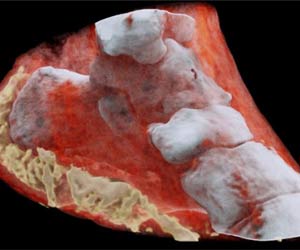
To answer this question, a large group of researchers in Europe set out to compare three different X-ray phase tomography methods at the European Synchrotron Radiation Facility's (ESRF) beamline ID19 in France—X-ray grating interferometry, propagation-based phase tomography with single-distance phase reconstruction, and holotomography.
Led by Irene Zanette, a scientist affiliated with both ESRF and the Technische Universität München (TUM) in Germany, the researchers put these three techniques to the test by examining cancerous tissue from a mouse model and an entire rat's heart, which they report this week in the Journal of Applied Physics, from AIP Publishing.
Along with colleagues Bert Müller, group leader of the Biomaterials Science Center in Switzerland, and Timm Weitkamp, a scientist at the Synchrotron SOLEIL in France, the team explored which method performs best in terms of spatial resolution and visualization/quantification of relevant features in the samples. They also investigated other related factors such as the simplicity of the setup, and the data acquisition and analysis involved in each method.
To do this, the researchers chose to exploit synchrotron radiation, which produces significantly higher-quality X-rays than conventional X-ray generators such as those found in hospitals.
What exactly is synchrotron radiation? "Think of synchrotron radiation as being analogous to the sort of monochromatic, collimated and intense light produced by lasers, while conventional X-ray generators in hospitals are more analogous to light bulbs we use within our homes," explained Zanette, currently a postdoctoral scientist in biomedical physics at TUM in Germany.
Advertisement
Source-Eurekalert











